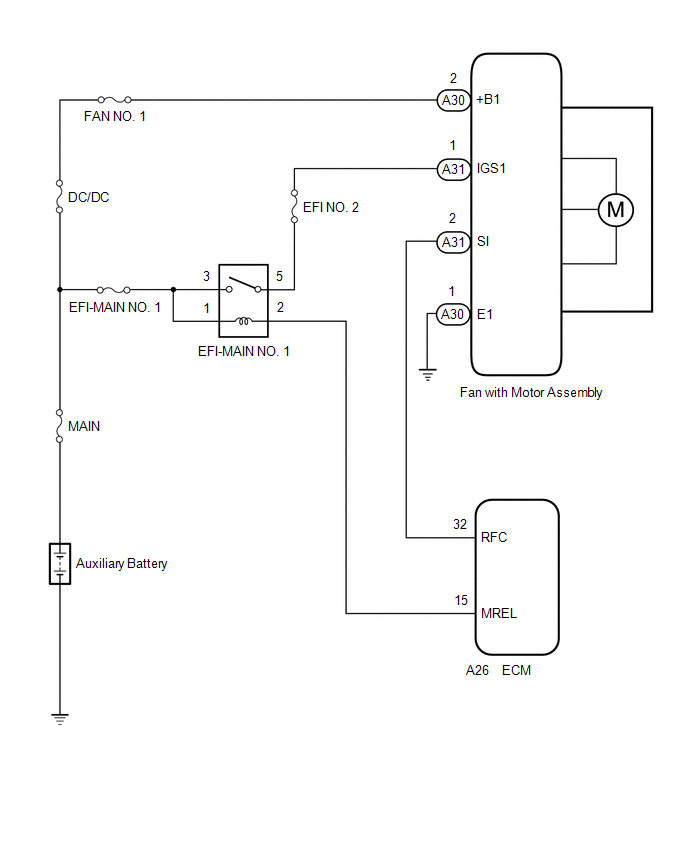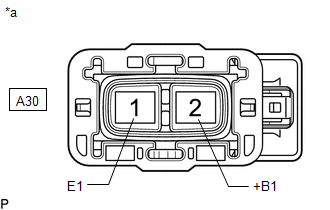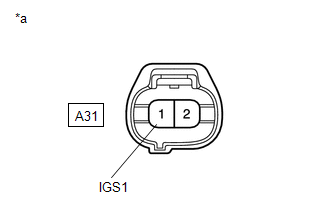Lexus ES: Cooling Fan Circuit
DESCRIPTION
The ECM calculates an appropriate cooling fan speed based on the engine coolant temperature, air conditioning switch status, refrigerant pressure, engine speed and vehicle speed, and sends a signal to the cooling fan ECU (fan with motor assembly). The cooling fan ECU (fan with motor assembly) steplessly control the speed of the cooling fan based on the duty cycle signal sent from the ECM. By sending signals to the cooling fan ECU (fan with motor assembly) in accordance with the driving conditions and by controlling the cooling fan speed optimally with the ECM, both high cooling performance and quietness are ensured.
WIRING DIAGRAM

CAUTION / NOTICE / HINT
NOTICE:
- Inspect the fuses for circuits related to this system before performing the following procedure.
-
Make sure to perform the necessary procedures (adjustment, calibration, initialization, or registration) after parts related to the cooling fan system have been removed/installed or replaced.
Click here
.gif)
.gif)
.gif)
.gif)
PROCEDURE
| 1. | PERFORM ACTIVE TEST USING TECHSTREAM (CONTROL THE ENGINE COOLING FAN DUTY RATIO) |
(a) Connect the Techstream to the DLC3.
(b) Turn the power switch on (IG).
(c) Turn the Techstream on.
(d) Enter the following menus: Powertrain / Engine / Active Test / Control the Engine Cooling Fan Duty Ratio.
Powertrain > Engine > Active Test| Tester Display |
|---|
| Control the Engine Cooling Fan Duty Ratio |
(e) Check the operation of the cooling fan while operating it using the Techstream.
OK:
| Techstream Operation | Fan Operation |
|---|---|
| 30 - 100% | Cooling fan operates |
| 0% | Cooling fan stops |
| Result | Proceed to |
|---|---|
| OK | A |
| Cooling fan does not operate | B |
| Cooling fan does not stop | C |
| A | .gif) | PROCEED TO NEXT SUSPECTED AREA SHOWN IN PROBLEM SYMPTOMS TABLE |
| C | .gif) | GO TO STEP 8 |
|
| 2. | CHECK HARNESS AND CONNECTOR (FAN WITH MOTOR ASSEMBLY - ECM) |
(a) Disconnect the A31 fan with motor assembly connector.
(b) Disconnect the A26 ECM connector.
(c) Measure the resistance according to the value(s) in the table below.
Standard Resistance:
| Tester Connection | Condition | Specified Condition |
|---|---|---|
| A31-2 (SI) or A26-32 (RFC) - Body ground | Always | 10 kΩ or higher |
| NG | .gif) | REPAIR OR REPLACE HARNESS OR CONNECTOR (FAN WITH MOTOR ASSEMBLY - ECM) |
|
| 3. | INSPECT ECM (RFC TERMINAL) |
(a) Disconnect the A31 fan with motor assembly connector.
(b) Connect the Techstream to the DLC3.
(c) Turn the power switch on (IG).
(d) Turn the Techstream on.
(e) Enter the following menus: Powertrain / Engine / Active Test / Control the Engine Cooling Fan Duty Ratio.
Powertrain > Engine > Active Test| Tester Display |
|---|
| Control the Engine Cooling Fan Duty Ratio |
(f) Operate the cooling fan motor (fan with motor assembly) using the Active Test function and measure the resistance according to the value(s) in the table below.
Standard Resistance:
| Tester Connection | Techstream Operation | Specified Condition |
|---|---|---|
| A31-2 (SI) - Body ground | Before Active Test (0%) → During Active Test (100%) | Before Active Test (0%): Resistance is stable → During Active Test (100%): Resistance fluctuates* |
HINT:
*: Using the Active Test, duty control of the transistors in the ECM will be performed. Due to the duty control, resistance of the RFC terminal will be unstable during the Active Test. If the resistance is stable before the Active Test and fluctuates while performing the Active Test, it can be determined that the transistor is operating. If the transistor does not operate during the Active Test, the ECM may be malfunctioning.
| NG | .gif) | REPLACE ECM |
|
| 4. | CHECK HARNESS AND CONNECTOR (FAN WITH MOTOR ASSEMBLY POWER SOURCE) |
(a) Disconnect the A30 fan with motor assembly connector.

| *a | Front view of wire harness connector (to Fan with Motor Assembly) |
(b) Measure the voltage according to the value(s) in the table below.
Standard Voltage:
| Tester Connection | Condition | Specified Condition |
|---|---|---|
| A30-2 (+B1) - A30-1 (E1) | Always | 11 to 14 V |
| NG | .gif) | GO TO STEP 7 |
|
| 5. | CHECK HARNESS AND CONNECTOR (FAN WITH MOTOR ASSEMBLY POWER SOURCE) |
(a) Disconnect the A31 fan with motor assembly connector.
(b) Turn the power switch on (IG).
| (c) Measure the voltage according to the value(s) in the table below. Standard Voltage:
|
|
| OK | .gif) | REPLACE FAN WITH MOTOR ASSEMBLY |
|
| 6. | CHECK HARNESS AND CONNECTOR (FAN WITH MOTOR ASSEMBLY - EFI-MAIN NO. 1 RELAY) |
(a) Disconnect the A31 fan with motor assembly connector.
(b) Remove the EFI-MAIN NO. 1 relay from the No. 1 engine room relay block and No. 1 junction block assembly.
(c) Measure the resistance according to the value(s) in the table below.
Standard Resistance:
| Tester Connection | Condition | Specified Condition |
|---|---|---|
| A31-1 (IGS1) - 5 (EFI-MAIN NO. 1 relay) | Always | Below 1 Ω |
| OK | .gif) | CHECK ECM POWER SOURCE CIRCUIT |
| NG | .gif) | REPAIR OR REPLACE HARNESS OR CONNECTOR (FAN WITH MOTOR ASSEMBLY - EFI-MAIN NO. 1 RELAY) |
| 7. | CHECK HARNESS AND CONNECTOR (FAN WITH MOTOR ASSEMBLY - BODY GROUND) |
(a) Disconnect the A30 fan with motor assembly connector.
(b) Measure the resistance according to the value(s) in the table below.
Standard Resistance:
| Tester Connection | Condition | Specified Condition |
|---|---|---|
| A30-1 (E1) - Body ground | Always | Below 1 Ω |
| OK | .gif) | REPAIR OR REPLACE HARNESS OR CONNECTOR (FAN WITH MOTOR ASSEMBLY - AUXILIARY BATTERY) |
| NG | .gif) | REPAIR OR REPLACE HARNESS OR CONNECTOR (FAN WITH MOTOR ASSEMBLY - BODY GROUND) |
| 8. | INSPECT ECM (RFC TERMINAL) |
(a) Disconnect the A31 fan with motor assembly connector.
(b) Connect the Techstream to the DLC3.
(c) Turn the power switch on (IG).
(d) Turn the Techstream on.
(e) Enter the following menus: Powertrain / Engine / Active Test / Control the Engine Cooling Fan Duty Ratio.
Powertrain > Engine > Active Test| Tester Display |
|---|
| Control the Engine Cooling Fan Duty Ratio |
(f) Operate the cooling fan motor (fan with motor assembly) using the Active Test function and measure the resistance according to the value(s) in the table below.
Standard Resistance:
| Tester Connection | Techstream Operation | Specified Condition |
|---|---|---|
| A31-2 (SI) - Body ground | Before Active Test (0%) → During Active Test (100%) | Before Active Test (0%): Resistance is stable → During Active Test (100%): Resistance fluctuates* |
HINT:
*: Using the Active Test, duty control of the transistors in the ECM will be performed. Due to the duty control, resistance of the RFC terminal will be unstable during the Active Test. If the resistance is stable before the Active Test and fluctuates while performing the Active Test, it can be determined that the transistor is operating. If the transistor does not operate during the Active Test, the ECM may be malfunctioning.
| OK | .gif) | REPLACE FAN WITH MOTOR ASSEMBLY |
|
| 9. | CHECK HARNESS AND CONNECTOR (FAN WITH MOTOR ASSEMBLY - ECM) |
(a) Disconnect the A31 fan with motor assembly connector.
(b) Disconnect the A26 ECM connector.
(c) Measure the resistance according to the value(s) in the table below.
Standard Resistance:
| Tester Connection | Condition | Specified Condition |
|---|---|---|
| A31-2 (SI) - A26-32 (RFC) | Always | Below 1 Ω |
| OK | .gif) | REPLACE ECM |
| NG | .gif) | REPAIR OR REPLACE HARNESS OR CONNECTOR (FAN WITH MOTOR ASSEMBLY - ECM) |

.gif)

